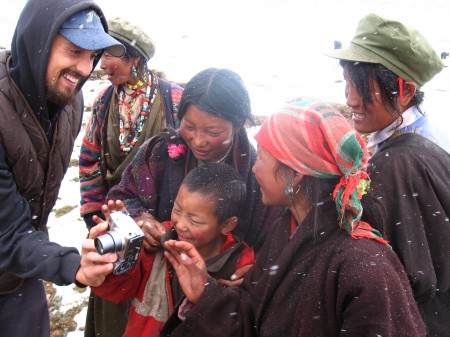Did you like this issue’s cover? We did!
Ricepaper had a chance to talk to Tom Carter, the photojournalist who shared with us one of the photos from his book, CHINA: Portrait of a People
1. We have received very positive feedback on your photo on the cover of our magazine (19.1). Can you tell us about where you were? Was the moment set up, or spontaneous? What was happening in the background?
This photograph was taken in northern China’s Liaoning province, on a beach in coastal Dalian, where I was wandering during my travels. Dalian is considered one of China’s most romantic cities, and an ubiquitous sight on its shores are pre-wedding photo sessions, with brides-to-be posing in fake gowns (held together with clips) to emulate Western tradition. But I also spotted a number of elderly people diving into the sea, which is quite uncommon as many Mainlanders never learn to swim (summer on a beach here is a big rainbow of inner tubes). Even more uncommon anywhere in China are public displays of affection, especially among the older generation who were married into an affectionless era. So capturing this candid moment of loyalty, longevity and love was rather special, and that’s why I chose to include it in my photography book CHINA: Portrait of a People, which is where you all first spotted it.
2. What is the most inspirational place you have visited as an artist? Why?
I generally can’t answer this type of question; as a traveler, inspiration is dynamic and constantly being renewed by new geography and new circumstances. The first time I ever started seriously writing was whilst backpacking down the length of Mexico. I holed up in Zihuatanejo for two months and banged out my memoirs (which I doubt will ever be read let alone published). The sheer excitement of being in China reinvigorated my interest in photography, and I carried a camera at my side every moment for 4 years (2 just living and 2 backpacking). I also traveled across India for a year, where I took some of my best photographs (which I credit to India rather than my own skills); some of those photos appear in my wife Hong Mei’s (who accompanied me) new Chinese-language book about our adventures together, The Farther I Walk, The Closer I Get To Me (走得越远,离自己越近).
3. As a photographer, you must have a vast archive to select from. What elements do you look for when you select photos for showcasing in a collection?
I do, but oddly enough I don’t look through my photos anymore. I mean, I had to for CHINA: Portrait of a People, which was a month-long process with my publisher just to sift through them all and choose the best of the best. But I’ve never gone through them after that. Same for India. Nor have I ever showcased my work in a gallery, but that’s mostly just because I can’t afford frames, heh. The sad fact is that my photography career never really took off; just when I was getting good at it, the bottom dropped out of the photojournalism industry, DSLRs and HDR and Instahipstagramatic became all the rage, and the net oversaturated with auto-perfect pictures. Photography today is no longer special, nor even really “real,” so it’s not something I’m doing anymore. Maybe in, like, 50 years someone will appreciate my body of work, and the lengths I went through to get it.
4. You have recently edited a collection of expatriate essays set in China, Unsavory Elements. How is the process of capturing an image through the lens different from telling a story with words for you?
This is a good question; in all the interviews I’ve given nobody has ever compared my photography snapshots with the cultural snapshots I compiled for my anthology. And that’s what I was trying to do: just as CHINA: Portrait tells a visual story of China’s diversity and captures every aspect of daily life here, Unsavory Elements is a collection of vignettes that depict nearly every imaginable experience a foreign expatriate living or traveling in China might have. And as the editor I was very conscious about making sure my writers described the smallest details, properly framed their circumstances just as a photographer does, and then cropped them down to a tight portrait like in post-production. I really enjoyed being an editor and am keen on assembling future anthologies about China. I just hope I can find a benefactor to back my future projects, because I’ve gone into the poorhouse from all these DIY endeavors.
###
An inveterate vagrant who flirts with pictures and words, Tom Carter spent 2 straight years backpacking a groundbreaking 35,000 miles across all 33 Chinese provinces, and was named “one of China’s foremost explorers” by The World of Chinese magazine. His first book CHINA: Portrait of a People has been hailed as the most comprehensive book of photography on modern China ever published by a single author. He is also the editor of Unsavory Elements, an anthology about foreign expats in China. Tom has called China home since 2004.
Links:
CHINA: Portrait of a People on Amazon Canada
http://www.amazon.ca/CHINA-Portrait-People-Tom-Carter/dp/9889979942/
Unsavory Elements on Amazon Canada
http://www.amazon.ca/Unsavory-Elements-Stories-Foreigners-Loose/dp/9881616409/
The Farther I Walk, The Closer I Get To Me (走得越远,离自己越近) on Amazon China
